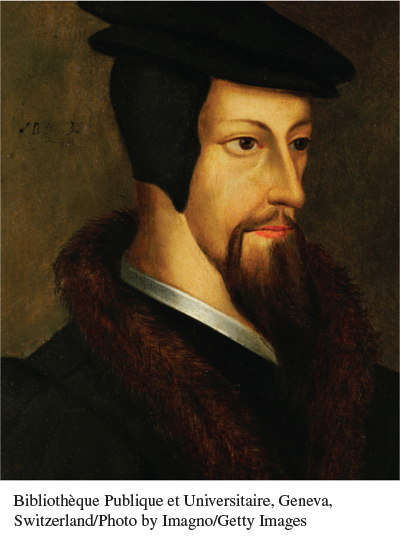A History of Western Society: Printed Page 411
A History of Western Society, Value Edition: Printed Page 393
A History of Western Society, Concise Edition: Printed Page 411
Calvinism

In 1509, while Luther was preparing for a doctorate at Wittenberg, John Calvin (1509–1564) was born in Noyon in northwestern France. As a young man he studied law, which had a decisive impact on his mind and later his thought. In 1533 he experienced a religious crisis, as a result of which he converted to Protestantism.
Calvin believed that God had specifically selected him to reform the church. Accordingly, he accepted an invitation to assist in the reformation of the city of Geneva. There, beginning in 1541, Calvin worked assiduously to establish a well-
To understand Calvin’s Geneva, it is necessary to understand Calvin’s ideas. These he embodied in The Institutes of the Christian Religion, published first in 1536 and in its final form in 1559. The cornerstone of Calvin’s theology was his belief in the absolute sovereignty and omnipotence of God and the total weakness of humanity. Before the infinite power of God, he asserted, men and women are as insignificant as grains of sand.
Calvin did not ascribe free will to human beings because that would detract from the sovereignty of God. Men and women cannot actively work to achieve salvation; rather, God in his infinite wisdom decided at the beginning of time who would be saved and who damned. This viewpoint constitutes the theological principle called predestination.Calvin explained his view:
Predestination we call the eternal decree of God, by which he has determined in himself, what he would have become of every individual. . . .
Many people consider the doctrine of predestination, which dates back to Saint Augustine and Saint Paul, to be a pessimistic view of the nature of God. But “this terrible decree,” as even Calvin called it, did not lead to pessimism or fatalism. Instead, many Calvinists came to believe that although one’s own actions could do nothing to change one’s fate, hard work, thrift, and proper moral conduct could serve as signs that one was among the “elect” chosen for salvation.
Calvin transformed Geneva into a community based on his religious principles. The most powerful organization in the city became the Consistory, a group of laymen and pastors charged with investigating and disciplining deviations from proper doctrine and conduct. (See “Thinking Like a Historian: Social Discipline in the Reformation.”)
Serious crimes and heresy were handled by the civil authorities, which, with the Consistory’s approval, sometimes used torture to extract confessions. Between 1542 and 1546 alone seventy-
Geneva became the model of a Christian community for many Protestant reformers. Religious refugees from France, England, Spain, Scotland, and Italy visited Calvin’s Geneva, and many of the most prominent exiles from Mary Tudor’s England stayed. Subsequently, the church of Calvin — often termed “Reformed” — served as the model for the Presbyterian Church in Scotland, the Huguenot Church in France (see “French Religious Wars”), and the Puritan churches in England and New England.
Calvinism became the compelling force in international Protestantism. Calvinists believed that any occupation could be a God-
Calvinism spread on the continent of Europe, and also found a ready audience in Scotland. There, as elsewhere, political authority was the decisive influence in reform. The monarchy was weak, and factions of virtually independent nobles competed for power. King James V and his daughter Mary, Queen of Scots, staunch Catholics and close allies of Catholic France, opposed reform, but the Scottish nobles supported it. One man, John Knox (1505?–1572), dominated the reform movement, which led to the establishment of a state church.
Knox was determined to structure the Scottish Church after the model of Geneva, where he had studied and worked with Calvin. In 1560 Knox persuaded the Scottish Parliament, which was dominated by reform-